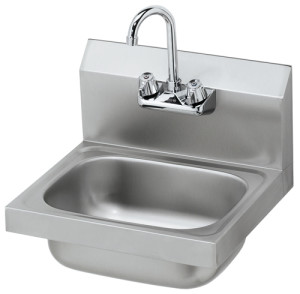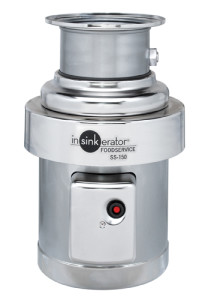More than likely, your restaurant has several commercial sinks that serve many purposes in the back of the house, in server stations, and behind the bar. Having the right kind of sinks in the right places is important not only to accomplish many various tasks, from glass and hand washing to stock pot and flatware cleaning, it’s also a vital part of your food safety program, and something that health inspectors will focus on.
First, let’s get the basics out of the way. Most of you probably already know this stuff because you have to set up your sinks properly to pass inspection. But if you’re thinking about starting a brand new restaurant, the following info will be very helpful.
For the rest of you, skip past this and read some additional, VERY IMPORTANT information, unless you’re looking for one of the sinks or faucets listed below. Click the link if this is the case.
Types of Commercial Sinks:

- Hand Sinks: hand sinks are pretty standard sinks for washing your hands. Keep the dishes out.
- Kitchen Sinks: choose from 1, 2, 3, or 4 compartment kitchen sinks for rinsing and washing dishes. An HACCP program requires a 3 compartment sink for the proper sanitization of dishes. Review the procedure here. If you want to wash and fill stock pots and other big cookware items, get a big sized compartment sink.
- Bar Sinks: 3 compartment bar sinks are designed for glass washing behind the bar.
- With all these sinks, make sure you buy NSF approved only! NSF sinks have features that prevent the buildup of grime and bacteria, like welded drainboards and sealed seams that eliminate spaces.
Types of Commercial Faucets:

- Deck Mount Faucets: deck mount faucets mount directly onto the sink. Make sure you measure the hole centers, or the distance between the center of the two holes where the faucet will mount on your sink, before ordering.
- Wall Mount Faucets: these faucets mount from the wall and come through the backsplash. Wall mount faucets are by far the most common type in restaurants.
- Pot Filler Assemblies: these are a specialized wall mount faucet with a hose or extended, swiveling spout that allows you to easily fill big stock pots.
- Pre-Rinse Assemblies: these assemblies are designed to help staff quickly rinse dirty cookware and tableware before it goes into your dish machine.
It’s always going to be easier to install the type of faucet that your sinks and kitchen’s plumbing are set up for. If the sink in question has holes for a deck mount faucet and your pipes come vertically out of the floor, use a deck mount. If you have plumbing coming horizontally out of the wall, by all means use a wall mount faucet.
If you skipped down, start here.
Leaky commercial faucets can waste thousands of gallons of water every year! That costs your restaurant money, especially if it’s the hot water that’s leaking. Over time, the washers in a stem assembly become worn, which means they don’t form a perfect seal when the handle is turned off. This allows water to leak out even though the faucet is turned off. These washers are less than $5, and they can save you hundreds of dollars in utility costs over the course of a year.
Caring For Commercial Sinks and Faucets
Commercial sinks and faucets are made from stainless steel. Stainless steel is a great material because it’s durable and rust resistant, but a couple simple maintenance techniques can extend the life cycle of any sink or faucet.
Never use abrasive pads or detergents. Steel isn’t stainless or rust resistant. There is actually a thin film of chromium and/or nickel that covers the steel and gives it it’s shine and prevents rust from forming. When you use an abrasive pad or detergent to clean stainless steel, this thin film becomes scored and develops holes, which allows rust to move in.
Wipe sinks and faucets down daily. Moisture is rust’s best friend, and the sinks and faucets in your kitchen are necessarily wet all day. When you clean out your sinks at the end of the day, however, make sure you wipe them down with a soft rag. This prevents moisture and rust from working together overnight to tarnish and rust your sinks and faucets.
Use a Garbage Disposer

In kitchen sinks that collect food waste from washing cookware and tableware, installing a garbage disposer is important. Not only does it increase your kitchen’s efficiency since you don’t have to clean out and dispose of food waste separately, a garbage disposer also makes your restaurant green. That’s because you keep food waste out of landfills and conserve water by reducing sink cleaning time. Sending food waste down the drain also keeps it out of trash cans and dumpsters in your kitchen, where it decomposes quickly, breeding bacteria and nasty smells.
Commercial sinks are easy to forget about. It’s one of those things you have to worry about when you first open a restaurant, and don’t really think about afterwards. But properly maintaining your sinks and faucets, repairing them quickly when they leak, and equipping them properly with things like pot fillers and garbage disposers, not only makes your operation more efficient, it can translate into significant savings later on.
 Corner Booth Blog | TundraFMP Restaurant Supply, News & Equipment Blog
Corner Booth Blog | TundraFMP Restaurant Supply, News & Equipment Blog




Nice review of the different kinds of sinks. There were some models that I had always been wondering about.
Thanks so much for this article. Really made this move painless.